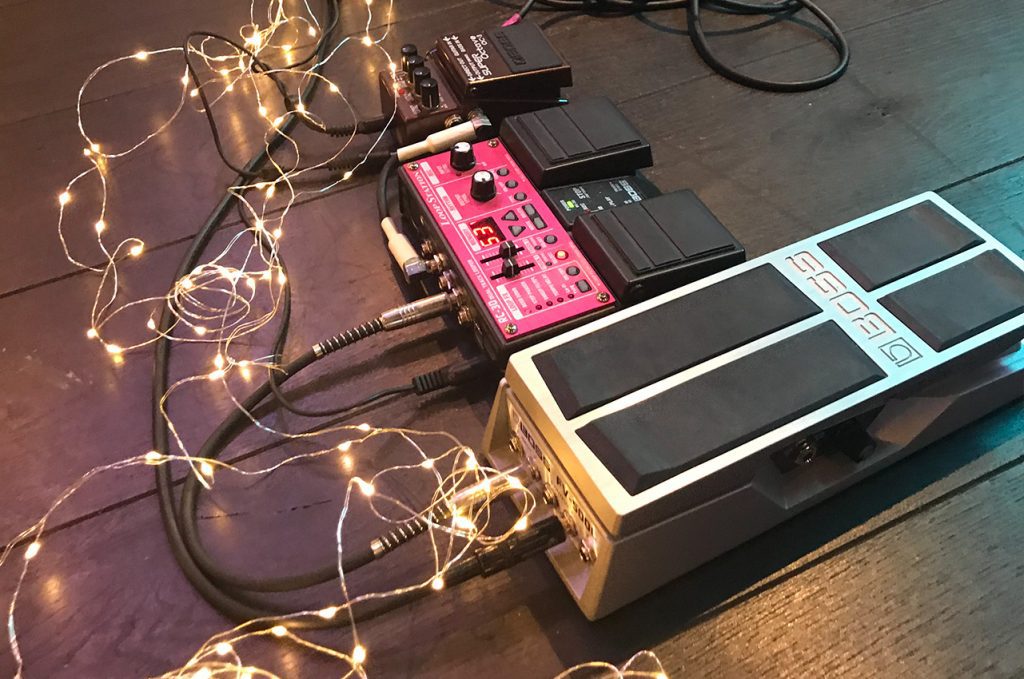1) Minimalistic loops
Don’t be afraid of simplicity. Sometimes a very minimalistic loop can be a perfect background for a very creative improvisation. The more space you leave in the loop, the more you can say with your improvisation because you won’t be so constraint by the background. It’s like having a very bare canvas with just a texture or a few drops of paint – it gives you so much freedom to interact with it!
I invite you to explore this idea of creating a minimalistic loop, for example, using just a simple ostinato pattern. Don’t add too many layers to it. Maybe just a first layer with the ostinato notes and a second layer with very sparse sound effects. Once the minimalistic loop is built, improvise freely over it bringing all the complexity and abstraction with your soloing.
2) In your layers, less is more
Don’t be afraid of silence. If you had the experience to play the violin in a musical band, you know that you always need to find your musical space in the band by listening and interacting with the other musicians. You need to find something to contribute to what they are playing that enhances the overall result.
The same is true when we are looping. When we add a new layer to our loop, we need to be careful about the volume, intensity and complexity of that layer, and how it interacts with the rest of the loop. It’s useful to always ask ourselves whether what we are playing is actually enhancing the music or not. Sometimes adding another layer can make the music less clear and less musical. Maybe that layer is too busy, or it’s too loud, or the notes are too legato. Try subtracting something from that layer to see if it can fit better with the rest of the loop. If you struggle to achieve that, consider that sometimes silence can be a much better addition.
3) The amazing textures of the violin
The violin is a very expressive instrument that allows us to produce sounds with a variety of articulations and textures that make it the perfect instrument for looping. With all the sound possibilities of the violin, we can use the looper pedal to create the full effect of a band or a string quartet. I encourage you to explore different articulations and sound textures and combine them in your loops as if every layer were a different musician. Here are some ideas of the sounds you can explore in your violin looping:
- Bow articulations: legato, staccato, spicatto, flutato, etc.
- Pizzicato: Plucking many strings at once to produce chords like a guitar, playing pizzicato arpeggios that create the celestial effect of a harp, or playing a catchy riff with pizzicato.
- Percussion: Adding rhythm with the chopping technique, or creating groovy riffs with strum bowing technique.
- Sound effects: Adding non-rhythmic sound effects like tapping the strings, making squeaking noises, playing chains of harmonics, rattling sounds…
- Using the mute to create a more melancholy and soft sound.
4) Cultivating a creative oasis
Looping allows you to improvise and explore your creativity all by yourself without the pressure of a social setting like a concert or a jam session. It is a safe space where you can develop your ideas, try new things and connect to your musical voice without being observed or judged by others. This is your creative oasis.
Keep this space sacred and pure by not judging yourself and your music. Instead of labeling your music as good or bad, just observe whether you like it or not and whether you are enjoying it or not. That’s the only thing that matters!
If you liked the looping ideas I shared in this post, you are going to love my Violin Looping Course! I created this course for violinists who want to have a deeper connection with their instrument and let their creativity flow through jamming and composing their own music. The video course is organized in 15 lessons, with more than 240 minutes of video content, where I show you a step-by-step method for creating your own music with a violin and a loop pedal. The lessons are progressive, with tons of examples and clear assignments that will get you jamming right from the very first lesson.
Join me today and start discovering the amazing musical worlds you can create with your violin and the looper pedal.


